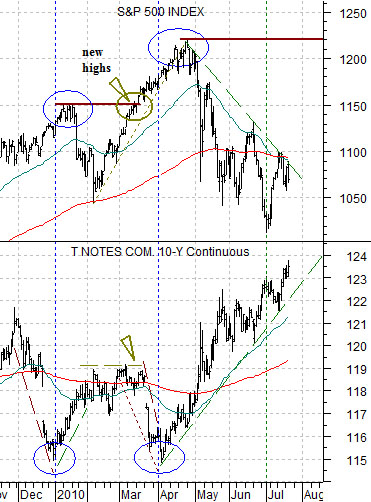The reality is that money continues to flee risk as long-term bond prices trend higher. To argue in favor of the equity market is, to a certain extent, to argue against the bond market. In past issues we have stated time and time again that betting against the bond market is rarely a good idea. Yet… we apparently are going to do exactly that in today’s issue.
Below is a comparative view of the S&P 500 Index (SPX), the ratio between copper and gold futures, and the ratio between the share price of Goldman Sachs (GS) and the CBOE Volatility Index (VIX).
The copper/gold ratio tends to trend with long-term Treasury yields. When copper prices are stronger than gold prices the trend for yields is usually higher while strength in gold goes with falling yields.
The GS/VIX ratio is something that we cobbled together back in 2008. The argument was that GS represents one form of ‘the market’ while the VIX tends to rise in response to cyclical weakness. A rising ratio reflects a more bullish trend for cyclical growth.
In late 2008 the GS/VIX ratio bottomed and turned higher as the Asian equity markets began to recover. A month or so later the copper/gold ratio reached bottom indicating that long-term Treasury yields had at least stopped falling.
With both ratios turning higher the base trend for the SPX was starting to improve although it would take into March of 2009 before this index finally pivoted back to the upside.
Our point is that the GS/VIX ratio reached a correction low in May of this year while the copper/gold ratio found bottom in June. For the past one to two months both ratios have been rising suggesting that even in the face of falling interest rates there is a potential trend pointing towards a return to cyclical growth.
To the extent that the SPX lagged the recovery for both ratios by a number of months from the end of 2008 into early 2009 our view is that as long as these ratios are tracking higher it is only a matter of time before stock prices swing upwards. Of course ‘only a matter of time’ might mean weeks or even months of lower equity prices butwe tend to feel a bit more optimistic when we can see the light at the end of the tunnel.

Equity/Bond Markets
There is a very strong inverse relationship between equities and bonds at present. Our concern is that the bond market tends to be ‘right’ and since it keeps making new highs… the path of least resistance for stocks is still clearly lower.
Since we are going to argue with this assertion we might as well attempt to explain why we are following such a dangerous path.
Below is a chart comparison between the SPX and the U.S. 10-year T-Note futures.
The first point is that when bonds go up… stocks go down. Conversely when stocks go up… bonds go down.
The second point is that the bond market has tended to set the trend when bonds bottom and turn higher while equities set the trend when they bottom and turn higher.
At the ends of December 2009 and March 2010 the bond market bottomed and turned higher. The equity markets continued to push upwards as the previous quarter’s earnings were released in January and April.
Once the bulk of earnings were reported the stock market collapsed as an offset to rising bond prices. In both instances the rising trend for bond prices ultimately served to crater the equity markets.
In early February the equity market bottomed and turned higher. This marked the high point for bond prices. Yet the bond market did not begin to weaken until the second half of March as the SPX moved to new recovery highs.
The argument has been that we might not need weaker bond prices to swing the equity markets higher; rather strong equity prices will serve to first cap the rise in the bond market (similar to last February) while a very strong equity market may be required to actually pull bond prices lower.
Further below is a comparison between copper futures and the price spread or difference between 30-year and 10-year Treasury futures. The 30-10 spread is another way of viewing the overall trend for bond prices.
Our view is that copper prices trend inversely to bond prices. In other words as long as copper prices were trending lower it made sense that bond prices were still rising.
This particular argument put copper prices and the SPX on the same side of the equation. If copper futures OR the SPX broke up through the resistance line then our sense was that the other would follow in short order with bond prices turning back to the down side.
The problem yesterday was that copper futures broke out through support but the SPX failed once again at the resistance line as long-term Treasury prices rose to new recovery highs. If copper futures do not fail back below 3.00 later this week a case can be made that the first crack in the rising trend for bond prices has finally emerged.





